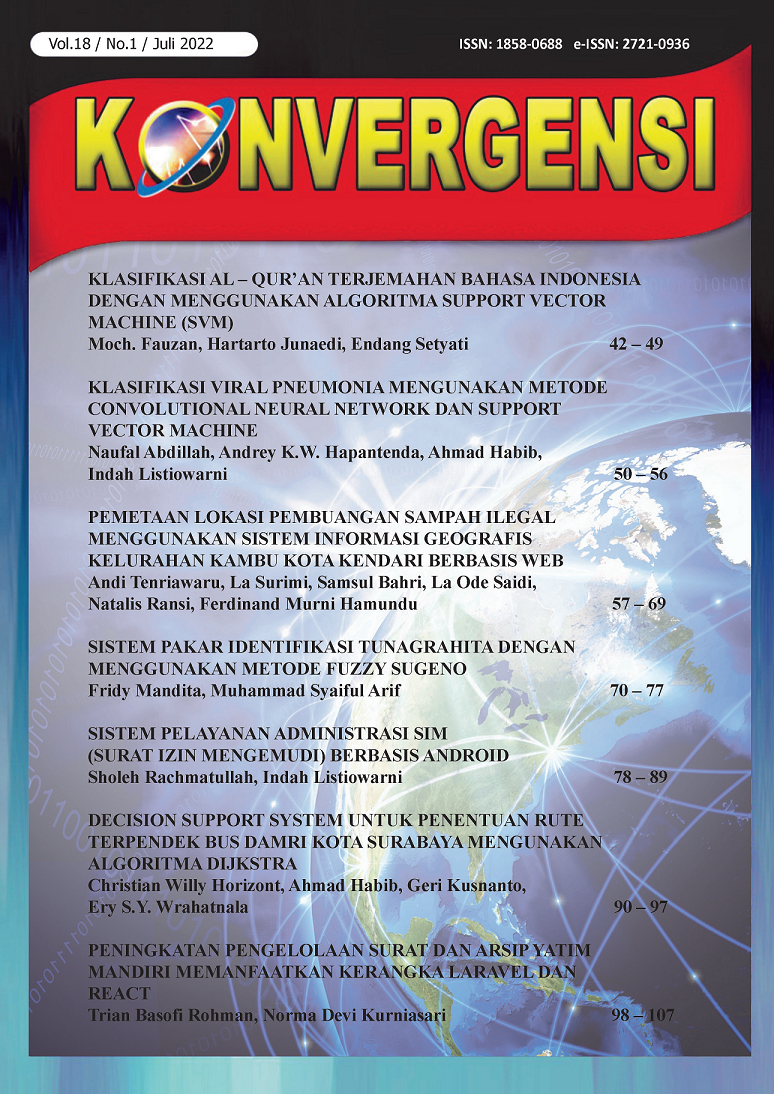PEMETAAN LOKASI PEMBUANGAN SAMPAH ILEGAL MENGGUNAKAN SISTEM INFORMASI GEOGRAFIS KELURAHAN KAMBU KOTA KENDARI BERBASIS WEB
Abstract
This project intends to develop a web-based geographic information system design for mapping the location of illegal waste disposal, by taking the coordinates in Kambu Village, Kendari City. Kendari City is one of the cities that has a problem with illegal dumping sites. This is due to the large population, resulting in an increase in waste that is not managed properly. However, not all people, especially migrants, know the location of illegal waste disposal in Kambu Village. This system is intended to assist users by providing details of the distribution of illegal trash bins in Kambu Village. The waterfall technique is used for system development in this study. The process of designing information systems is easier to understand with this method. This technology can display a map of the distribution of illegal landfills. Black box testing and usability testing are used in the system testing process. According to the test findings, the system functions well and produces a usability value of 3.77 – 4.43.
Keywords: GIS, waterfall, website, LPSI, Black box testing, and usability
ABSTRAK
Proyek ini bermaksud untuk membangun sebuah desain sistem informasi geografis pemetaan lokasi pembuangan sampah ilegal berbasis web, dengan mengambil titik koordinat di Kelurahan Kambu Kota Kendari. Kota Kendari termasuk kota yang memiliki masalah lokasi pembuangan sampah ilegal. Hal ini disebabkan oleh jumlah penduduk yang banyak sehingga mengakibatkan bertambahnya sampah yang tidak dikelola dengan baik. Namun, tidak semua masyarakat khususnya pendatang mengetahui lokasi pembuangan sampah ilegal yang ada di Kelurahan Kambu. Sistem ini dimaksudkan untuk membantu pengguna dengan memberikan rincian distribusi tempat sampah ilegal di Kelurahan Kambu. Teknik waterfall digunakan untuk pengembangan sistem pada penelitian ini. Proses perancangan sistem informasi lebih mudah dipahami dengan metode ini. Teknologi ini dapat menampilkan peta persebaran tempat pembuangan sampah ilegal. Black box testing dan usability Nielsen digunakan dalam proses pengujian sistem. Berdasarkan hasil pengujian diperoleh bahwa sistem berfungsi dengan baik dengan nilai usabilty sebesar 3.77 – 4.43.
Kata kunci: SIG, waterfall, website, LPSI, black box testing, dan usability
Downloads
References
I. Sukma, Maruji, and Gafrun, “Sistem Informasi Gografis dan Pelayanan Publik pada Kantor Polisi se-Kota Kendari Berbasis Web,” semanTIK, vol. 6, no. 2. pp. 69–74, 2020.
A. Simangunsong and M. Informatika, “Sistem Informasi Pengarsipan Dokumen Berbasis Web,” J. Mantik Penusa, vol. 2, no. 1, pp. 11–19, 2018, [Online]. Available: http://e-jurnal.pelitanusantara.ac.id/index.php/mantik/article/view/317
N. Intan, A. Kadir, and R. Tandi, “Strategi Pengelolaan Sampah pada Dinas Lingkungan Hidup dan Kehutanan Kota Kendari,” J. Publicuho, vol. 2, no. 4, p. 56, 2019, doi: 10.35817/jpu.v2i4.9933.
A. Mizwar and P. R. Kartini, “Aplikasi Sistem Informasi Geografis (Sig) untuk Pemetaan Sebaran Tempat Pembuangan Sampah Ilegal di Kota Banjarbaru, Kalimantan Selatan,” Jukung (Jurnal Tek. Lingkungan), vol. 2, no. 1, pp. 13–24, 2016, doi: 10.20527/jukung.v2i1.1058.
Adiriansyah and M. Akbar, “Sistem Informasi Geografis Lokasi Tempat Pembuangan Sementara Sampah Menggunakan Metode Prototype dan Metode Analisis Clustering di Kota Palembang,” Bina Darma Conf. Comput. Sci., pp. 2013–2023, 2015.
S. Kosasi, “Sistem Informasi Geografis Pemetaan Tempat Kost Berbasis Web,” CSRID J., vol. 6, no. 3, pp. 171–181, 2020, doi: 10.51967/tanesa.v21i1.320.
E. Siswandi and Wahyudin, “Pemetaan Tempat Penampungan Sampah (TPS) Ilegal Menggunakan Geographic Information System (Gis) di Wilayah Kecamatan Mataram Kota Mataram,” J. Ilm. MITSU, vol. 7, no. 2, pp. 8–16, 2019, doi: 10.24929/ft.v7i2.719.
M. Fadhli and R. A. Putri, “Rancang Bangun Aplikasi Pengaduan Tempat Pembuangan Sampah Ilegal Berbasis Map,” T e c h n o l o g i c a, vol. 1, pp. 32–42, 2022.
M. Kirom, “Sistem Informasi Geografis Pemetaan Suara Pemilukada Berbasis Open Source di Kabupaten Jombang,” Edutic - Sci. J. Informatics Educ., vol. 1, no. 1, pp. 1–12, 2015, doi: 10.21107/edutic.v1i1.400.
G. Lü, M. Batty, J. Strobl, H. Lin, A. X. Zhu, and M. Chen, “Reflections and speculations on the progress in Geographic Information Systems (GIS): a geographic perspective,” Int. J. Geogr. Inf. Sci., vol. 33, no. 2, pp. 346–367, 2019, doi: 10.1080/13658816.2018.1533136.
Devi, A. Setiawan, and E. Sediyono, “Seminar Nasional Pendidikan Matematika Ahmad Dahlan 2016 Penentuan Luas Lahan Menggunakan Metode Pendekatan Segitiga Sferik (Teorema Girard) dengan Bantuan Google MAPS,” pp. 240–247, 2016.
M. Susilo, “Rancang Bangun Website Toko Online Menggunakan Metode Waterfall,” InfoTekJar (Jurnal Nas. Inform. dan Teknol. Jaringan), vol. 2, no. 2, pp. 98–105, 2018, doi: 10.30743/infotekjar.v2i2.171.
T. S. Jaya, “Pengujian Aplikasi Dengan Metode Blackbox Testing Boundary Value Analysis (Studi Kasus: Kantor Digital Politeknik Negeri Lampung),” J. Inform. J. Pengemb. IT, vol. 3, no. 2, pp. 45–48, 2018.
Rizky and S. Lestari Giza, “Pengujian Usability pada Tangible Game sebagai media Promosi Candi,” INFOS Journal, vol. 2, no. 1. pp. 13–19, 2019.
Y. Laven, “Evaluasi Usability Berdasarkan Nielsen Model Menggunakan Metode Usability Testing Pada Web Sistem Informasi Akademik Universitas Tanjungpura,” Jurnal.Untan.Ac.Id, pp. 72–79, 2018.
Authors whose manuscript is published will approve the following provisions:
- The right to publication of all journal material published on the Konvergensi Teknologi Informasi & Komunikasi website is held by the editorial board with the author's knowledge (moral rights remain the property of the author).
- The formal legal provisions for access to digital articles of this electronic journal are subject to the terms of the Creative Commons Attribution-ShareAlike (CC BY-SA) license, which means Konvergensi Teknologi Informasi & Komunikasi reserves the right to store, modify the format, administer in database, maintain and publish articles without requesting permission from the Author as long as it keeps the Author's name as the owner of Copyright.
- Printed and electronic published manuscripts are open access for educational, research and library purposes. In addition to these objectives, the editorial board shall not be liable for violations of copyright law.




